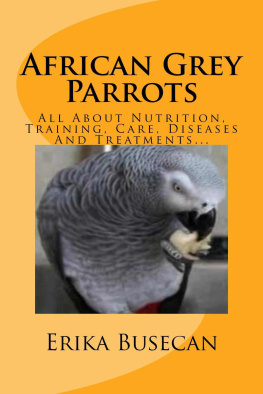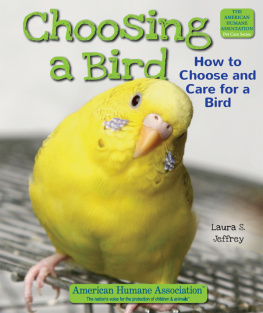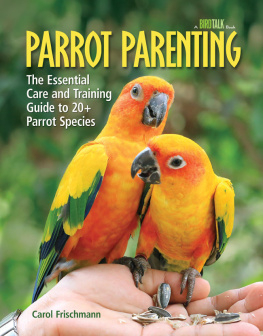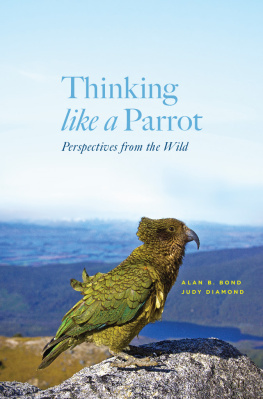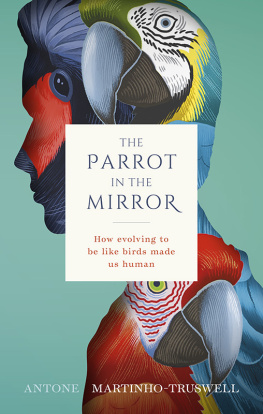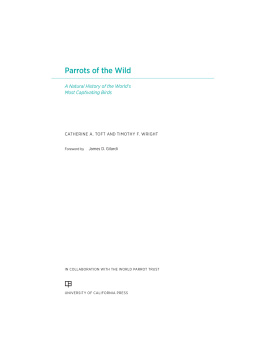African Grey Parrots
All About Nutrition, Training, Care, Diseases And Treatments
Copyright 2015 Erika Busecan
All rights reserved.
Contents
Introduction
Exotic birds-parrots
Congo African grey parrots
Description
Areas of Congo African grey parrot
Character
Lifespan
How to choose the right bird
General criteria
How to purchase a healthy bird
How to determine the parrot`s gender
Life with cage birds
Preparing your house for the new arrived parrot
The transportation of the parrots
The new arrived parrot`s diet
How to train your parrot
Talking and training
How to teach your parrot not to bite
Learn to observe your parrot`s body language
Cold season, hot season
How to care of your bird in cold season
How to care of your bird in hot season
Cages and accessories
Cage location
Cages
Aviaries
Roofing
Toys and accessories
The main diet of Congo African grey parrots
Cleaning your parrot`s house
Breeding
The anatomy of Congo African grey parrots
Respiratory organs
Digestive components
Urinary tract organs
Genital organs
The eyes
The ears
Molting
Stress bars
How to maintain your parrot`s health
The first sign of disease
Few advices about how to keep your parrot healthy
How to recognize the abnormal droppings
Feather picking and self-mutilation
How to catch and manipulate your parrot without hurting it
How to choose the right avian vet
What should you know, when you inform your vet
Microchipping your parrot
How to take care of the beak and the nails of your parrot
How to clip your parrot`s wings
Bathing your parrot
The special needs of the parrots
Flying exercises
Bedding materials
The everyday life of parrots
Inappropriate perches
What you can do if your parrot is escaping from the cage
How to prevent the escape
What you can do if your parrot has already escaped
How to hand feed a baby parrot
How to administer medication to your parrot
Adding medication in drinking water
Adding medication in food
Liquid medication (Suspensions)
Injectable medication
Vitamins and minerals excess or deficiency
First aid kit for your parrot
Trauma at parrots
Poor general condition
Forced feeding
Parasites
External parasites
Scab at parrots
Internal parasites
Skin and feather problems
Inflammation of the skin (Dermatitis)
Xanthomas (Fatty tumors)
Skin tumors (Lipomas)
The appetite and the digestive system
The bird doesn't want to eat and drink
The bird eats too much
When the bird has diarrhoea
Enteritis (Inflammation of the intestines)
Gastrointestinal parasites
Tapeworms
Capillaria ( Capillary or Threadworms)
Constipation
Obesity
Excessive weight loss
Inflammation of the crop
How to hand feed a baby parrot
How to administer medication to your parrot
Adding medication in drinking water
Adding medication in food
Liquid medication (Suspensions)
Injectable medication
Vitamins and minerals excess or deficiency
First aid kit for your parrot
Trauma at parrots
Poor general condition
Forced feeding
Parasites
External parasites
Scab at parrots
Internal parasites
Skin and feather problems
Inflammation of the skin (Dermatitis)
Xanthomas (Fatty tumors)
Skin tumors (Lipomas)
The appetite and the digestive system
The bird doesn't want to eat and drink
The bird eats too much
When the bird has diarrhoea
Enteritis (Inflammation of the intestines)
Gastrointestinal parasites
Tapeworms
Capillaria ( Capillary or Threadworms)
Constipation
Obesity
Liver diseases
Inflammation of the liver (Hepatitis)
Fatty liver
Beak`s health problems
Deformed beak
Soft beak
Injuries of the beak
Trichomoniasis parasites
Respiratory system problems
Acute respiratory insufficiency
Abundant nose secretion
Rhinitis
Sense organs problems
The eyes
The ears
Reproduction problems
The retention of the egg
Infertility of the cock
Nervous system problems
Dizzy bird
Twirling or Torticollis
Diseases of the feet
Abscess of the feet
Accidents and injuries of the limb
Sprains and dislocations
Fractures
Gout
Intoxications of the cage birds
Birds diseases which could affect humans
Contagious diseases at birds
Prevention of diseases
Viral diseases
Avian pseudo pest
Avipox at cage birds
Pacheco`s disease
Marek`s disease
Bacterial diseases
Salmonellosis
Psittacosis or parrot fever
Pasteurellosis
Mycoplasmosis
Mycotic diseases
Candida (Candidiasis)
Aspergillosis
Aviary plants and shrubs
Plants that could cause intoxication to your parrots
More from the author
Introduction
Our love for nature and exotic makes us try to bring close to us in our big or small apartments or houses, these wonderful creatures called, exotic birds.
They are just perfect to fulfill our lives and homes with their interesting singing voices and perfect plumage color.
If you don't own yet a bird and you want to purchase one, or you already have one and want to learn more interesting things about them like, how to understand your parrot`s behavior to avoid situation of biting, how to understand your parrot`s body language, how to teach them to talk, what steps you must follow if your bird is escaping and you want to bring it back, how to hand feed a baby parrot, how to recognize the abnormal droppings of your bird, how to administer medication to your parrot, how to help your bird when accidents happen, how to help your parrot when it has difficulty in delivering the eggs (the retention of the egg) and much much more, then this book could be interesting for you.
Exotic birds - parrots

Parrots, these extraordinary exotic birds, which are approximately 328 species, have definitely conquered the parrots breeders hearts, for over two hundred years.The amazing intelligence, the beauty of the gorgeous colorful plumage, the ease with which they can be trained and the great ability to imitate human language, made from parrots the most appreciated and most wanted cage birds.Their appearance on the European continent has its origin since ancient times.
Congo African grey parrot

The Congo African grey parrot ( Psittacus erithacus) can be found in West and Central Africa, in tropical forests, from Ivory Coast to West Kenya, Angola and South of Zaire.
In the wild they are very noisy birds and they live in flocks from 30 to 10 000 individuals. They are good flyers on short distances.
Grey parrots from some parts of Kenya, Tanzania and Zaire are much bigger and they have more vivid, pale red color on their feathers. The smaller and darker feather coloured exotic birds live in West side of the
area, from Ivory Coast to Angola.
Description

Next page
